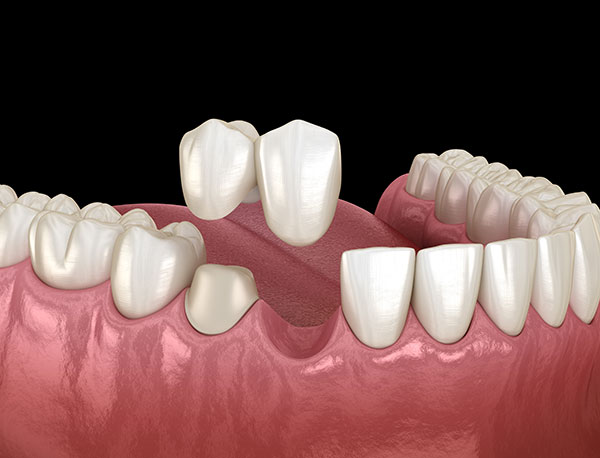Find Your Perfect Tooth Replacement
In the realm of restorative dentistry, various innovative solutions have emerged to address the challenges posed by missing teeth. Among these solutions, cantilever dental bridges have gained recognition as a distinctive approach to tooth replacement. Unlike traditional bridges that rely on support from both sides of a gap, cantilever bridges offer a unique design by anchoring to only one adjacent tooth.
Explore our cantilever dental bridges guide with our Sacramento dentist below.
What Are Cantilever Dental Bridges?
A cantilever dental bridge is used to replace a missing tooth when there’s only one adjacent supporting tooth. Unlike traditional bridges, which are held in place on both sides by dental crowns by the adjacent teeth, a cantilever dental bridge only needs to be cemented to a crown on one side. The tooth on the side of the artificial tooth is typically called the abutment tooth.
Cantilever bridges are typically made of ceramic and metal or entirely of ceramic material. They’re often used to replace a missing front tooth.
Benefits of Cantilever Dental Bridges
There are various benefits of cantilever dental bridges, including:
- Minimal Tooth Preparation: Cantilever dental bridges require minimal reduction of adjacent teeth. This means that the supporting teeth on one side of the gap undergo less alteration, preserving more of their natural structure.
- Preservation of Tooth Integrity: With less reduction of adjacent teeth, the risk of damaging healthy tooth structure is reduced. This can lead to better long-term oral health for the supporting teeth.
- Effective for Small Gaps: Cantilever bridges are particularly useful when replacing a single missing tooth or in cases where there’s only one tooth adjacent to the gap. This makes them a practical solution for specific tooth replacement scenarios.
- Simple Procedure: The placement of a cantilever bridge typically involves a simpler procedure compared to more complex options like implant-supported bridges. This can result in a quicker and less invasive treatment process.
- Cost-Effective: Cantilever bridges can be a more cost-effective option compared to some alternatives like implant-supported bridges. This can make them a more accessible choice for patients with budget constraints.
- Less Healing Time: Since the procedure is less invasive, patients often experience shorter healing times and less postoperative discomfort. This can lead to a quicker recovery and return to normal oral function.
How the Process Works
Initial Consultation
Schedule an appointment with your Sacramento dentist to discuss your tooth replacement needs. During the consultation, your dentist will evaluate your oral health, the condition of adjacent teeth, and the gap that needs to be filled.
Treatment Planning
If a cantilever bridge is deemed suitable, your dentist will develop a treatment plan. This plan will include considerations for the design of the bridge, material selection, and the overall approach to the procedure.
On the day of the procedure, your dentist will administer a local anesthetic to numb the area around the missing tooth and the adjacent teeth. This ensures you are comfortable during the treatment.
Tooth Preparation
The adjacent tooth (or teeth) that will serve as support for the cantilever bridge will be prepared. This involves removing a small amount of enamel from the supporting tooth to create space for the bridge.
Impression Taking
Once the tooth is prepared, your dentist will take impressions of your teeth. These impressions will be used to create a precise mold of your teeth, which will be sent to a dental laboratory to fabricate the bridge.
Temporary Bridge Placement
While your permanent bridge is being created, your dentist may place a temporary bridge to protect the prepared tooth and improve aesthetics.
Bridge Fabrication
A skilled dental laboratory technician will use the impressions to craft a custom-made cantilever bridge. The bridge will be designed to match the color, size, and shape of your natural teeth for a seamless appearance.
Permanent Bridge Placement
Once the permanent bridge is ready, you’ll return to the dentist’s office. The temporary bridge, if placed, will be removed, and the new cantilever bridge will be carefully fitted and adjusted as needed.
Bonding
The bridge will be bonded to the prepared adjacent tooth using dental cement. The dentist will ensure that the fit is comfortable and that your bite is properly aligned with the new bridge.
Final Adjustments
Your dentist will make any final adjustments to ensure that your new bridge feels comfortable and functions properly when you bite and chew.
Do You Need a Cantilever Dental Bridge?
Your dentist may recommend a cantilever bridge for patients for various reasons, including:
- Single Missing Tooth: Cantilever bridges are a viable option for individuals with a single missing tooth, especially when there’s only one tooth adjacent to the gap that can serve as support.
- Adjacent Tooth Strength: The adjacent tooth chosen for support should have good structural integrity and be free from significant dental issues like decay, gum disease, or extensive restorations.
- Small Gaps: Cantilever bridges work well for small gaps where only one tooth needs to be replaced. They are particularly effective when a traditional bridge with support on both sides isn’t feasible due to the lack of adjacent teeth.
Frequently Asked Questions
How long do cantilever dental bridges last?
With proper care and regular dental check-ups, cantilever dental bridges can last many years, potentially a decade or more. The lifespan of a cantilever dental bridge can vary depending on factors such as oral hygiene practices, the quality of the bridge materials, and the health of the supporting tooth. However, individual experiences may differ.
Are cantilever dental bridges permanent?
Yes, cantilever dental bridges are considered a permanent dental restoration. Once the bridge is placed and bonded to the adjacent tooth, it becomes a fixed part of your mouth. However, like all dental work, they might require occasional adjustments or replacements over time due to normal wear or changes in oral health.
Regain Your Full Smile With Cantilever Dental Bridges
Cantilever dental bridges, with their distinct design and benefits, provide a tailored solution for individuals facing specific tooth replacement challenges. By capitalizing on the strength of a single adjacent tooth, cantilever bridges offer a simpler procedure, reduced invasiveness, and cost-effective outcomes.
Contact our Sacramento dentist today at (916) 929-9222 to determine if cantilever bridges are the best choice for you!



